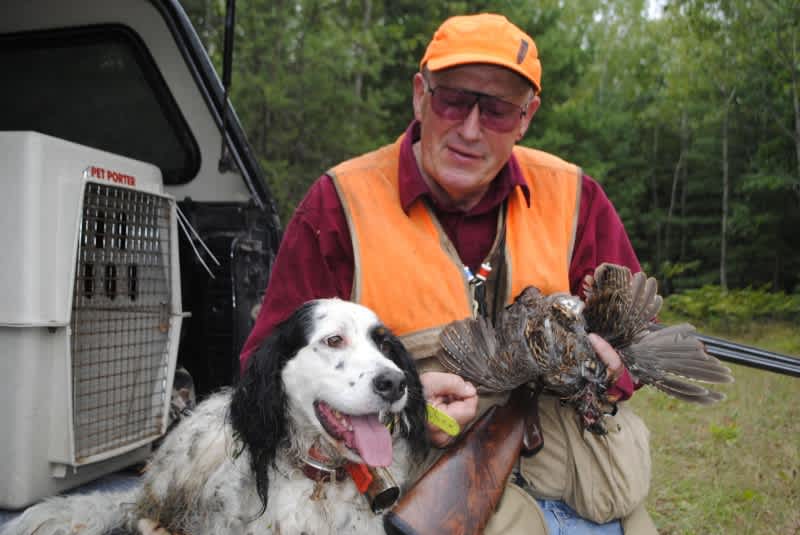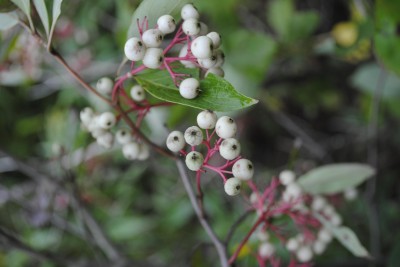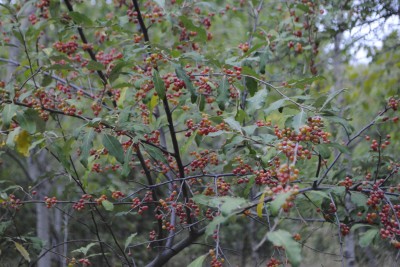Flushes Aplenty on Michigan’s Grouse Opener
Bob Gwizdz 10.01.13

When we got out of the truck well down a two-track and miles off any paved road, we could hear a ruffed grouse drumming in the distance. It was in the opposite direction of where we’d planned to go, but my partner, Al Stewart, suggested we try it, anyway.
You’ve got to admit there’s a certain challenge to trying to hunt a drumming grouse, no?
We headed into the aspen woods somewhere north of Clare, Michigan with our setters. Mine, Rub, is kind of a big-running dog. Tighe, one of Stewart’s setters, is a little closer-working dog. We wound our way downhill toward a thick alder bottom when Rub, who was leading the way by a good margin, slammed on point. Tighe immediately followed. But even as we picked up the tempo, the bird flushed well before we could get to the dogs.
“You don’t often kill a drumming bird,” said Stewart, who is the upland game bird specialist with the Michigan Department of Natural Resources (DNR) “They’re adult males, you’re in their territory, they know every inch of it, and they know every way out of it.”
Not getting grouse—in fact, not even seeing them when they flush—is par for the course during the early days of grouse season. So much so that some folks consider it a waste of time hunting grouse before October. Some would go so far as to suggest that the season opens too early.
But grouse managers, such as Stewart, will tell you there’s no reason not to go early as you’d miss out on opportunity.

Famed ruffed grouse researcher Gordon Gullion noted that when the so-called “fall shuffle” (when family groups break up) occurs, the grouse population begins to drop by one percent a day. Birds are moving into unfamiliar territories and the best habitat is already occupied by adult birds who don’t especially like interlopers. Grouse become more vulnerable to predation.
“That’s the reason to have seasons opening in early to mid-September—because you are already losing birds,” Stewart said.
And there’s not that many to start with. The grouse population, which generally follows a 10-year cycle, is on the downward slope right now in Michigan.
“Our most recent low occurred in 2004 or 2005,” said Stewart, who based that conclusion on three different studies: the fall grouse cooperators flush rate reports, the DNR’s small game hunter mail survey, and the spring drumming survey conducted by DNR biologists. “They all show these trends and each of these surveys is independent—they’re not related in any way.
“Our most recent high was around 2010, based on the same survey information,” he said.
If you look at recent survey results, you can see it. In 2011, cooperating grouse hunter in Michigan reported flushing two birds per hour. Last year, they reported 1.7. This year?
Well, the reports I’m getting from the field are that bird numbers are down. But you wouldn’t know it from what Stewart and I found on opening day.
To be fair, we were hunting some awfully good habitat, stuff that both of us have been hunting for years where there is some pretty active aspen harvest, so there’s always some improving habitat coming on. The bushes—dogwoods, viburnum, autumn olive—were heavy with fruit and the understory was thicker than an Alabama accent.
“As the population cycle heads downward, then you have to hunt the best habitat, which is normally dense stands of aspen six to 15 years old with a dense understory of dogwood, witch hazel, and alder,” Stewart said.
And that’s exactly the kind of stuff we were in.

Our first hour we flushed two grouse and one woodcock. But by three hours later, we were up a total of more than 50 flushes—and that’s not counting any obvious re-flushes. It was clear to me that we’d made contact with at least three different family groups of grouse; when you flush five in birds in three minutes—which we did three different times—you’ve got some pretty good evidence they were still in coveys.
The woodcock (the season on which would not open for another six days) held pretty tight for the dogs and came up in places where we probably could have had some pretty good shooting. But the grouse? Wild as jokers.
Of the flushes near me, I saw a grand total of three grouse. I managed to bring my gun to my shoulder twice—but never even got the safety off.
Stewart, who has a sixth sense about knowing which direction those birds are going to flush and always seems to position himself properly, managed to squeeze off two shells. He killed one bird.
But we did find several places where we planned to be the following Saturday when woodcock season opened. And we’d started getting in shape for that most glorious time of year. Most importantly, we’d gotten out.
“There are only so many days to hunt grouse,” Stewart said. “You want to take advantage of every one you can.
“And you get the dogs primed up for when it’s really good hunting in late October.”
For more information on Michigan hunting go to michigan.org. Click here to purchase a Michigan hunting license online.

